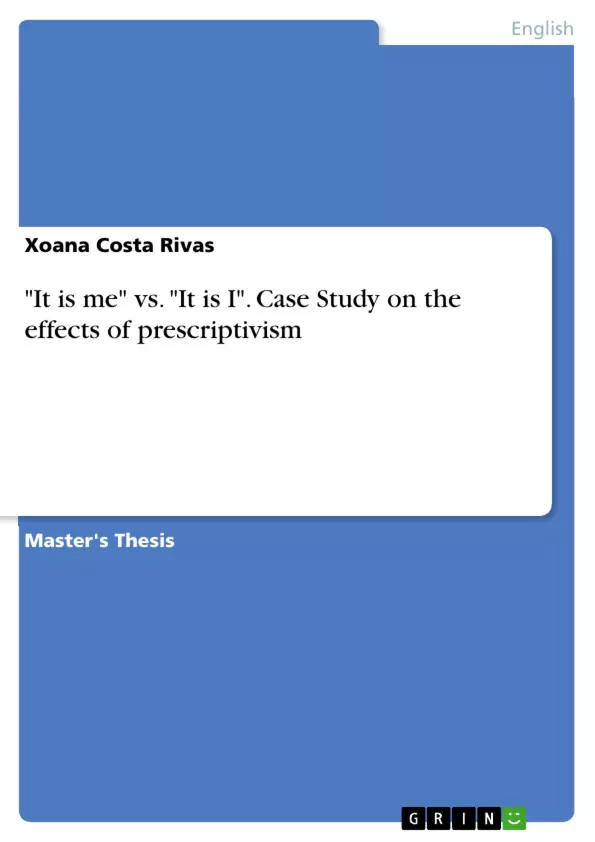English grammar writing started in the late 16th century and flourished during the 18th century. It was common for grammarians during this era to adopt a prescriptivist attitude towards language; that is, they would dictate norms of correct usage of the language rather than describing language use. This trend lost weight from the 19th century onwards.
One of the constructions prescriptive grammarians usually criticised was it is me, with an object case pronoun, as opposed to the traditionally correct it is I, with a subject case pronoun. The aim of this paper is to look at the reasoning behind grammarians’ choice of correct form, and assess the effects of prescriptivism on actual language use. This was done by looking at a self-compiled precept corpus made of 66 historical English grammars, ranging from the 16th to the 20th century, as well as a usage corpus (ARCHER and Old Bailey) with data from the same eras.
The results show prescriptivist negative comments towards it is me decreasing diachronically, and while grammars definitely did not advocate for the use of the object case pronoun in this construction, people still used it in their speech, but not, however, on their writings, which clearly indicates a division between the uses of these two constructions. It is me has, nonetheless, succeeded in becoming part of the present-day Standard.
This dissertation hopes to make a valuable contribution on the field of Normative Linguistics, and to be used as ground for future research.
Table of Contents
- 1. Introduction
- 2. Literature Review
- 2.1. English grammars, grammarians and grammar writing: the creation of the standard
- 2.2. The field of Normative Linguistics
- 2.3. Pilot study
- 3. Initial hypotheses, aims, and research questions.
- 4. Methodology
- 4.1. Precept Corpus
- 4.2. Usage Corpus
- 5. Results and discussion
- 5.1. Diachronic change in attitudes
- 5.2. Labels, reasons, and topics
- 5.3. Target audience
- 5.4. Author's place of birth
- 5.5. The dichotomy of gender: grammarians and target audience
- 5.6. The effects of prescriptivism on language use
- 6. The 'controverted phrase' nowadays
Objectives and Key Themes
This dissertation investigates the prescriptivist attitude towards the construction "it is me" in historical English grammars. It aims to analyze the reasoning behind grammarians' preference for the subject case pronoun ("it is I") and evaluate the impact of prescriptivism on actual language use. This research involves examining a self-compiled corpus of 66 historical English grammars from the 16th to the 20th century, alongside a usage corpus (ARCHER and Old Bailey) from the same periods.
- The evolution of prescriptivist attitudes towards "it is me" over time.
- The reasons behind grammarians' disapproval of the object case pronoun in this construction.
- The influence of prescriptivism on actual language use in speech and writing.
- The impact of factors such as target audience, author's background, and gender on prescriptivist views.
- The current status of "it is me" in contemporary Standard English.
Chapter Summaries
- Chapter 1: Introduction - This chapter provides an overview of the topic and sets the stage for the dissertation. It introduces the concept of prescriptivism in language and discusses the historical context of English grammar writing.
- Chapter 2: Literature Review - This chapter reviews relevant literature on English grammar writing, the field of Normative Linguistics, and previous studies related to the construction "it is me".
- Chapter 3: Initial hypotheses, aims, and research questions - This chapter outlines the research hypotheses, objectives, and specific research questions that guide the investigation.
- Chapter 4: Methodology - This chapter details the research methodology, including the creation and description of the precept corpus and the usage corpus.
- Chapter 5: Results and discussion - This chapter presents and analyzes the findings of the research, examining the diachronic change in attitudes towards "it is me", the reasons behind prescriptivist views, and the effects of prescriptivism on language use.
- Chapter 6: The 'controverted phrase' nowadays - This chapter discusses the current status of "it is me" in contemporary Standard English, considering its acceptance and use in modern language.
Keywords
The research focuses on the historical development of prescriptivism in English grammar writing, particularly examining the construction "it is me" and its evolution over time. Key concepts include Normative Linguistics, historical corpora, diachronic change, language use, and the influence of social factors on language attitudes.
- Citar trabajo
- Xoana Costa Rivas (Autor), 2015, "It is me" vs. "It is I". Case Study on the effects of prescriptivism, Múnich, GRIN Verlag, https://www.grin.com/document/342209



